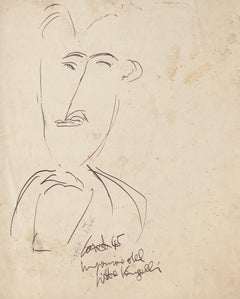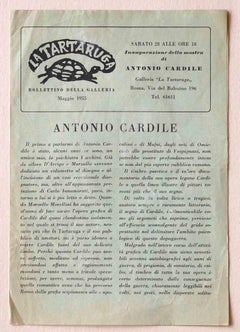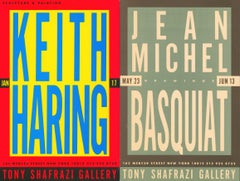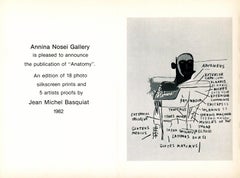Antonio Cardile Art
to
1
1
Overall Width
to
Overall Height
to
1
1
1
2
1
1
1
1
1
1
1
1
1
1
2
10,138
2,779
1,375
1,369
2
Artist: Antonio Cardile
Portrait of Antonio Vangelli - Pen Drawing By Antonio Cardile - 1945
By Antonio Cardile
Located in Roma, IT
The portrait of Vangelli is an original drawing in pen on paper, realized by Antonio Cardile in 1945, the portrait is Italian painter Vangelli, which is depicted through quick and de...
Category
1940s Modern Antonio Cardile Art
Materials
Pen
La Tartaruga Gallery Catalogue - Vintage Catalog after A. Cardile- 1955
By Antonio Cardile
Located in Roma, IT
La Tartaruga Gallery Catalogue is a vintage catalog issued in 1955.
It was realized for the exhibition of Antonio Cardile in La Tartaruga Gallery in ...
Category
Late 19th Century Modern Antonio Cardile Art
Materials
Paper, Offset
Related Items
1980's Basquiat Keith Haring announcements (set of 2)
By Jean-Michel Basquiat
Located in NEW YORK, NY
Jean-Michel Basquiat and Keith Haring at Tony Shafrazi Gallery 1987:
Set of two individual 1980’s exhibition announcements published during both artist’s lifetime. Looks very cool fr...
Category
1980s Pop Art Antonio Cardile Art
Materials
Offset, Paper, Lithograph
Basquiat Annina Nosei Gallery 1982 (Basquiat anatomy announcement)
By Jean-Michel Basquiat
Located in NEW YORK, NY
Jean-Michel Basquiat, Annina Nosei Gallery, New York, 1982:
Rare Basquiat announcement card published by Annina Nosei Gallery to advertise the release of ‘Basquiat Anatomy’ (a suite ...
Category
1980s Abstract Antonio Cardile Art
Materials
Paper, Lithograph, Offset
Keith Haring Citykids 1986 (sticker)
By Keith Haring
Located in NEW YORK, NY
Keith Haring for New York CityKids, 1986.
Rare vintage 1986 sticker illustrated by Keith Haring for the CityKids coalition in New York:
"City Kids Speak on Liberty" New York, 1986 sponsored by Burger...
Category
1980s Pop Art Antonio Cardile Art
Materials
Paper, Offset
Keith Haring Pop Shop Tokyo 1988 (stickers)
By Keith Haring
Located in NEW YORK, NY
Keith Haring Pop Shop Tokyo 1988:
Rare vintage original 1980s large-sized Keith Haring Tokyo Pop Shop sticker sheet, that is well-suited for framing. Designed by Haring in conjunctio...
Category
1980s Pop Art Antonio Cardile Art
Materials
Paper, Offset
Josef Albers LP Cover Art, set of 7 (Josef Albers album art)
By Josef Albers
Located in NEW YORK, NY
Josef Albers Album Art complete set of 7 circa late 1950s:
A set of 7 vinyl record covers (containing their records) brilliantly designed by Josef Albers between 1958 and 1960. The s...
Category
Mid-20th Century American Modern Antonio Cardile Art
Materials
Offset
$880 Sale Price
20% Off
H 12 in W 12 in
KAWS One (early KAWS artist book)
By KAWS
Located in NEW YORK, NY
KAWS One: KAWS Artist Monograph, 1st edition, 2001
Hardcover book, 80 pages
Rare and out of print. A definitive look back at the development of the artist's style and early beginning...
Category
21st Century and Contemporary Pop Art Antonio Cardile Art
Materials
Paper, Offset
Indian Dancer - Vintage Illustration in Ink and Watercolor
By Irene Pattinson
Located in Soquel, CA
Indian Dancer - Vintage Illustration in Ink and Watercolor
A stoic, dark-haired woman in elaborate dress is sitting cross-legged in this illustration by Irene Pattinson (American, 1909-1999). Pattinson uses fine ink line detail and a vibrant pink watercolor for a splash of color.
Signed at the bottom, "Irene Pattinson."
Provenance: The Artist, Estate of Irene Pattinson: David Carlson; Estate of Larry Miller Fine Art, Robert Azensky Fine Art.
Presented in a new white mat with foam core backing.
Mat size: 16"H x 12"W
Paper size: 11.75"H x 8.5"W
Image size: 7.5"H x 6.5"W
Irene Pattinson (American, 1909-1999) studied at the California School of Fine Art (now The San Francisco Art Institute), San Francisco State College and The Marion Hartwell School of Design. She was President of the San Francisco Woman Artists Association 1955-56.
Provenance: The Artist, Estate of Irene Pattinson: David Carlson; Estate of Larry Miller Fine Art, Robert Azensky Fine Art.
Solo Exhibitions: Lucien Labaudt Gallery 1955; San Francisco Museum of Art, 1961 (39 works).
Selected Group Exhibitions: San Francisco Art Association Annual 1948, 54, 55; San Francisco Woman Artists, 1957-1960; Oakland Art Museum Annual, 1951, 58; California Palace of the Legion of Honor, 1960; Richmond Art Center, 1955, 56, 57, 58; San Francisco Art Institute 1959, 60. The Art Bank of the San Francisco Art Association, 1958, 59, 60, 62, 63; Winter Invitational, California Palace of The Legion of Honor, San Francisco, 1960; Fourth Winter Invitational, California Palace of The Legion of Honor, San Francisco, 1963.
Awards: First Place, San Francisco Woman Artists Assoc., 1957, 1959; San Francisco Art Festival 1957;Literature: San Francisco Art Institute - A catalog of the Art Ban 1962/63; San Francisco and the Second Wave: The Blair Collection
Exhibitions:
1963 The Art Bank of the San Francisco Art Association, San Francisco, CA
1963 California Palace of The Legion of Honor: Forth Winter Invitational, San Francisco, CA
1962 The Art Bank of the San Francisco Art Association, San Francisco, CA
1961 San Francisco Museum of Art, San Francisco, CA
1960 California...
Category
1950s American Modern Antonio Cardile Art
Materials
Paper, India Ink, Watercolor, Pen
$1,150
H 16 in W 12 in D 0.25 in
Hardly
By Wassily Kandinsky
Located in Brooklyn, NY
"Hardly" is a captivating poster featuring the artwork of renowned artist Wassily Kandinsky. Published by Art Unlimited in Holland for the Museum Boymans-van Beuningen in Rotterdam, ...
Category
20th Century Modern Antonio Cardile Art
Materials
Offset
African Mama - Vintage Illustration in Ink and Watercolor
By Irene Pattinson
Located in Soquel, CA
African Mama - Vintage Illustration in Ink and Watercolor
A charming illustration, by Irene Pattinson (American, 1909-1999), shows a woman with a...
Category
1950s American Modern Antonio Cardile Art
Materials
Paper, India Ink, Watercolor, Pen
$795
H 13 in W 10 in D 0.25 in
Robert Colescott Semaphore gallery 1980 (announcement)
Located in NEW YORK, NY
Robert Colescott Semaphore 1980:
Rare original 1980s announcement card published on the occasion of Robert Colescott's exhibition at Semaphore Gallery from January 6 - January 31, 1980; 462 West Broadway, New York, NY. Features an offset illustration of Colescott's work "The Collector (Tea for Two)" from 1980.
Medium: Offset printed gallery announcement card.
Approximate Dimensions: 4 x 6 inches
Good overall vintage condition. Post marked on the reverse.
Unsigned from an edition of unknown.
Robert Colescott was an African-American artist known for his expressionistic paintings which dealt with his identity and Black history. In his work George Washington Carver Crossing the Delaware: Page from an American History Textbook (1975), Colescott humorously conflated the famous Emanuel Gottlieb Leutze painting of George Washington with the pioneering African-American chemist. Born Robert H. Colescott on August 26, 1925 in Oakland, CA, he played instruments and saw the work of his parents’ friend Sargent Johnson as well as Diego Rivera painting...
Category
1980s Pop Art Antonio Cardile Art
Materials
Paper, Offset
Mid-Century French Feutre on Paper. Tea time In the Kitchen.
Located in Cotignac, FR
Late Mid Century French feutre drawing on paper of a Provençal lady sitting in her kitchen by Jean Arène. Signed and dated bottom left.
This artwork is a striking pen-and-ink drawing that vividly captures a cluttered interior scene filled with an assortment of teapots and household objects. The central figure, an elderly lady with an expressive face, sits at a table surrounded by an overwhelming array of details. The artist uses bold, dynamic lines to convey a sense of chaos and charm, creating an atmosphere of cozy clutter. The composition’s intricacy draws the viewer's eye around the room, showcasing...
Category
1960s Expressionist Antonio Cardile Art
Materials
Paper, Felt Pen
$1,225
H 33.94 in W 27.52 in D 0.79 in
Jean Michel Basquiat en el Museo Nacional de Bellas Artes Exhibition Catalog
By Jean-Michel Basquiat
Located in NEW YORK, NY
Jean-Michel Basquiat, Works on Paper: rare vintage catalog to the 1997 exhibit at the Museu Nacional de Bellas Artes, Buenos Aires, Argentina.
Illustrat...
Category
1990s Pop Art Antonio Cardile Art
Materials
Offset, Paper
Antonio Cardile art for sale on 1stDibs.
Find a wide variety of authentic Antonio Cardile art available for sale on 1stDibs. You can also browse by medium to find art by Antonio Cardile in offset print, paper, pen and more. Much of the original work by this artist or collective was created during the 1940s and is mostly associated with the modern style. Not every interior allows for large Antonio Cardile art, so small editions measuring 9 inches across are available. Antonio Cardile art prices can differ depending upon medium, time period and other attributes. On 1stDibs, the price for these items starts at $339 and tops out at $390, while the average work can sell for $364.



